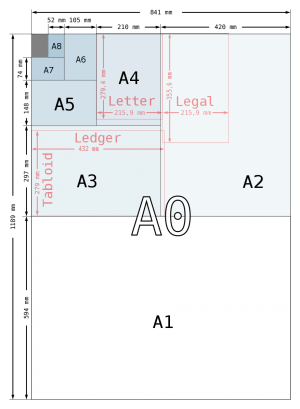Page Sizes: Difference between revisions
No edit summary |
No edit summary |
||
| Line 10: | Line 10: | ||
=== British Imperial System === | === British Imperial System === | ||
In 1846, the United Kingdom standardized their paper sizes with the Imperial system of paper dimensions and weights. This system, measured in inches squared instead of millimeters squared, had inconsistent aspect ratios. They also had unique names, such as "Double Crown, Elephant, Double Elephant, Demy, Double Pott and Columbier." Once the UK metricated, or adapted to the metric system, in the mid-20th century, ISO 216 paper size system was implemented, most notably replacing foolscap and quarto paper (which, despite their names, were not defined by the number of folds made on a sheet before cutting) with A4 paper. The Foolscap, however, took longer to disappear and was still used in office writing, until the mid-1980's.<ref name = "Three"> ''“British Imperial Paper Sizes.” Paper Sizes Header, www.papersizes.org/old-imperial-sizes.htm.'' <ref | In 1846, the United Kingdom standardized their paper sizes with the Imperial system of paper dimensions and weights. This system, measured in inches squared instead of millimeters squared, had inconsistent aspect ratios. They also had unique names, such as "Double Crown, Elephant, Double Elephant, Demy, Double Pott and Columbier." Once the UK metricated, or adapted to the metric system, in the mid-20th century, ISO 216 paper size system was implemented, most notably replacing foolscap and quarto paper (which, despite their names, were not defined by the number of folds made on a sheet before cutting) with A4 paper. The Foolscap, however, took longer to disappear and was still used in office writing, until the mid-1980's.<ref name = "Three"> ''“British Imperial Paper Sizes.” Paper Sizes Header, www.papersizes.org/old-imperial-sizes.htm.'' </ref> | ||
=== Traditional French Paper Sizes === | === Traditional French Paper Sizes === | ||
France also had its own paper size system before implementing the ISO standard system in 1967. The paper sizes followed the AFNOR, France's Standardization Association standard, that were established in 1926. The most common were the Carré, which is comparable to the ISO A2, Couronne, Raisin, and Jésus, all of which are much larger than today's common ISO A4. Like the United Kingdom, France stopped using the traditional sizes when they adopted the 216 system. <ref name = "Four"> ''“Paper Sizes.” Cloche, Pot, Écolier, Tellière, Couronne Écriture, Couronne Édition, Roberto, Écu, Coquille, Carré, Demi-Raisin, papersizes.io/french/. '' <ref | France also had its own paper size system before implementing the ISO standard system in 1967. The paper sizes followed the AFNOR, France's Standardization Association standard, that were established in 1926. The most common were the Carré, which is comparable to the ISO A2, Couronne, Raisin, and Jésus, all of which are much larger than today's common ISO A4. Like the United Kingdom, France stopped using the traditional sizes when they adopted the 216 system. <ref name = "Four"> ''“Paper Sizes.” Cloche, Pot, Écolier, Tellière, Couronne Écriture, Couronne Édition, Roberto, Écu, Coquille, Carré, Demi-Raisin, papersizes.io/french/. '' </ref> | ||
== International Standardizations == | == International Standardizations == | ||
Revision as of 22:13, 9 December 2020
Paper size standards of books have varied by country before the implementation of the ISO 216 standard that is the international standard, except in North America and part of Latin America.

Before ISO 216 Standardization
Since early books were exclusively handmade materials, page sizes varied considerably and without any stand for uniformity. During the manual paper making process, the size of the paper was governed by the size of the framed screen used to hold and mould the paper material solution. The 19th century introduced the invention of metal presses, allowed for increased strength of the press and larger pages.[1] But variations in paper and sheet sizes persist in hand production, since paper mills measure their paper differently; measuring from teh outside or inside edge of each deckle. This could result in a 1/2 inch difference in size.[2]
British Imperial System
In 1846, the United Kingdom standardized their paper sizes with the Imperial system of paper dimensions and weights. This system, measured in inches squared instead of millimeters squared, had inconsistent aspect ratios. They also had unique names, such as "Double Crown, Elephant, Double Elephant, Demy, Double Pott and Columbier." Once the UK metricated, or adapted to the metric system, in the mid-20th century, ISO 216 paper size system was implemented, most notably replacing foolscap and quarto paper (which, despite their names, were not defined by the number of folds made on a sheet before cutting) with A4 paper. The Foolscap, however, took longer to disappear and was still used in office writing, until the mid-1980's.[3]
Traditional French Paper Sizes
France also had its own paper size system before implementing the ISO standard system in 1967. The paper sizes followed the AFNOR, France's Standardization Association standard, that were established in 1926. The most common were the Carré, which is comparable to the ISO A2, Couronne, Raisin, and Jésus, all of which are much larger than today's common ISO A4. Like the United Kingdom, France stopped using the traditional sizes when they adopted the 216 system. [4]
International Standardizations
German physicist, Georg Christoph Lichtenberg appears to be have proposed the standardized paper size system [[1]]
North American Standardizations
References
Bloom, Jonathan. Paper Before Print: the History and Impact of Paper In the Islamic World. E-book, New Haven: Yale University Press, 2001, https://hdl-handle-net.proxy.library.upenn.edu/2027/heb.06496. Accessed 3 Dec 2020.
Notes
- ↑ Drucker, Johanna. “Chapter 5: The Invention and Spread of Printing.” History of the Book, University of California, Los Angelos.
- ↑ Mayes, Derek. “Traditional Paper Sizes.” Vintage Paper Co, 16 Mar. 2019, vintagepaper.co/blogs/news/traditional-paper-sizes.
- ↑ “British Imperial Paper Sizes.” Paper Sizes Header, www.papersizes.org/old-imperial-sizes.htm.
- ↑ “Paper Sizes.” Cloche, Pot, Écolier, Tellière, Couronne Écriture, Couronne Édition, Roberto, Écu, Coquille, Carré, Demi-Raisin, papersizes.io/french/.